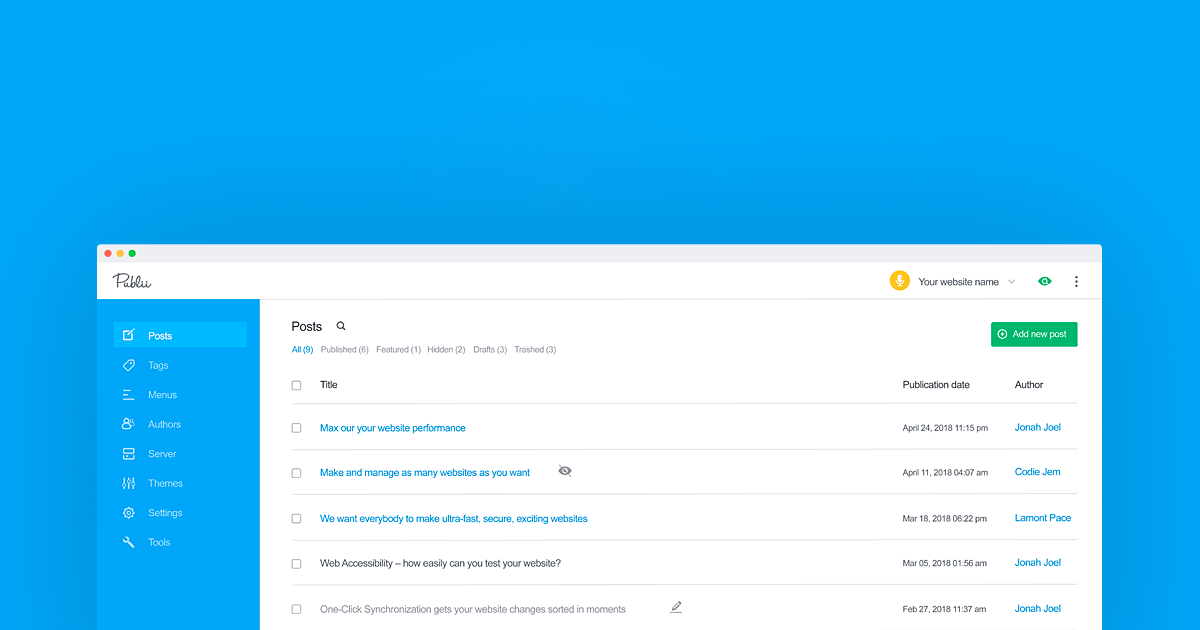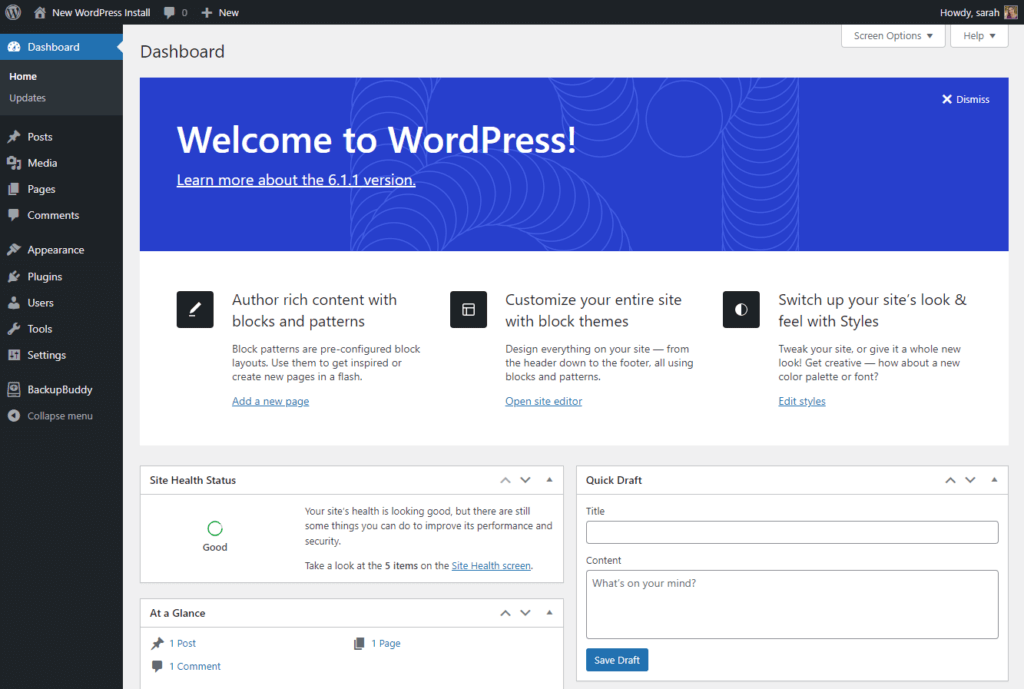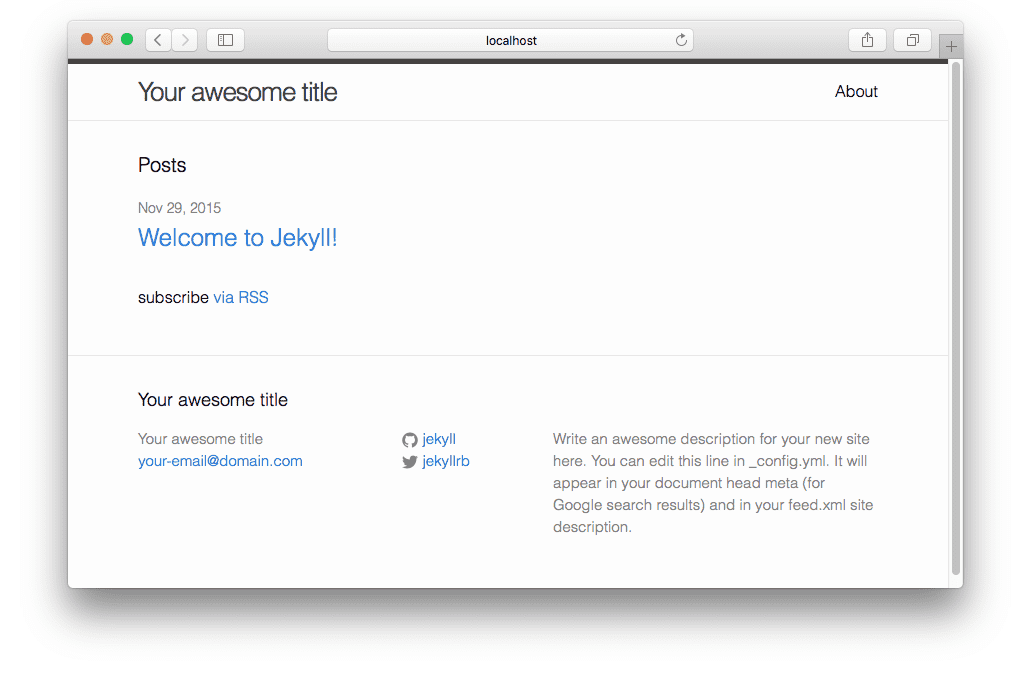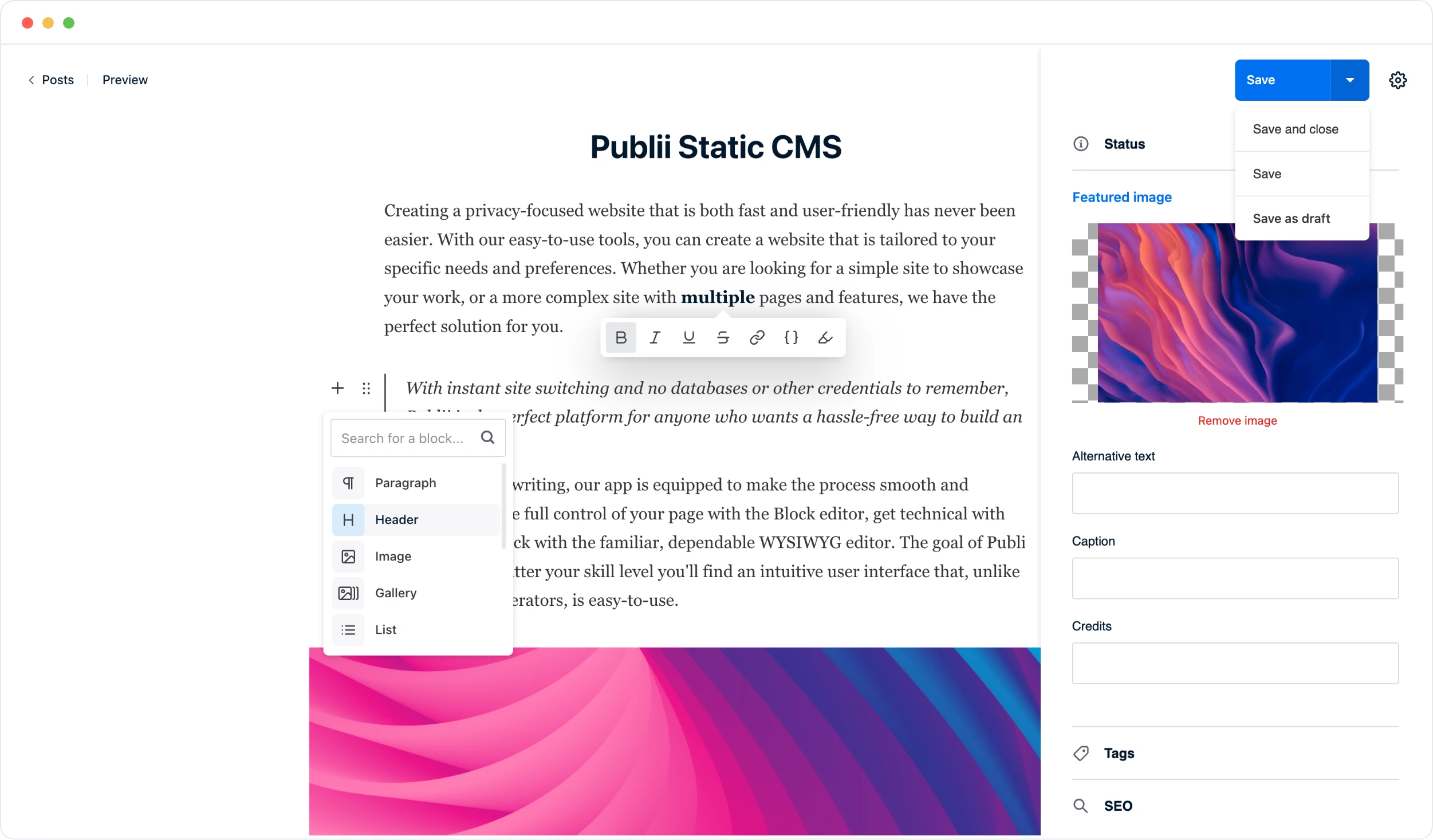Rethinking Blogging Platforms: The Case for Publii Over WordPress

Table of Contents
Introduction
In the digital age, where content is king, blogging has emerged as a powerful tool for individuals and businesses to share ideas, insights, and stories. Whether it's a personal blog chronicling a journey, a professional site showcasing expertise, or a business platform engaging customers, the choice of a blogging platform plays a crucial role in shaping the success of the endeavor.
For years, WordPress has been the dominant force in the blogging world, powering millions of websites with its user-friendly interface and extensive customization options. Its popularity has made it the default choice for many, from novice bloggers to established enterprises. But as technology evolves, so do the needs and expectations of users.
Enter the world of Static Site Generators (SSGs), a new breed of tools that are challenging the traditional dynamics of web development. Among them, Publii stands out as a promising alternative, offering a fresh approach to creating and managing blogs. Unlike WordPress, which relies on dynamic rendering, Publii leverages the simplicity and efficiency of static websites.
But what exactly are static websites, and why might they be a better choice for some bloggers? How does Publii compare to WordPress, and what are the factors to consider when choosing between these platforms? This article delves into these questions, exploring the landscape of modern blogging and making a case for why you might want to consider Publii instead of WordPress for your next blogging project.
We'll examine the strengths and weaknesses of both dynamic and static websites, uncover the hidden costs of WordPress, explore the benefits of static websites, and introduce you to Publii, a user-friendly Static Site Generator that could revolutionize the way you blog.
Whether you're a seasoned blogger looking to optimize your site or a newcomer seeking the best platform for your needs, this comprehensive guide will provide valuable insights to inform your decision-making process. So, let's embark on this exploration and discover why Publii might be the perfect fit for your blogging needs.
The Popularity of WordPress
In the vast landscape of content management systems, WordPress stands as a towering figure, powering a significant portion of the world's websites. Its reputation as an accessible and versatile platform has made it the go-to choice for bloggers, businesses, and developers alike. But what exactly makes WordPress so attractive to such a diverse user base? And are there hidden costs that potential users should be aware of?
This exploration delves into the core aspects that contribute to WordPress's widespread appeal, including its ease of use, extensive customization options, and robust community support. These features have solidified WordPress's position as a leading platform for web development.
However, it's not all smooth sailing. Along with its many advantages, WordPress also comes with hidden costs that may not be immediately apparent. From security vulnerabilities to performance issues and maintenance challenges, understanding these hidden aspects is crucial for anyone considering WordPress as their platform of choice.

What Makes WordPress Attractive?
1. Ease of Use
WordPress's user-friendly interface is one of its most appealing features. The intuitive dashboard is designed with simplicity in mind, allowing even those with no coding experience to navigate it with ease. The platform offers visual editors that enable users to see changes in real-time, simplifying content creation and formatting. Many hosting providers offer one-click WordPress installations, making the setup process quick and hassle-free. Additionally, the abundance of online tutorials and guides ensures that help is always available for users at all skill levels.
2. Customization
The extensive customization options available in WordPress are another significant draw. The diverse themes cater to various styles and functionalities, from minimalist blog designs to complex e-commerce layouts. Plugins extend the capabilities of a WordPress site, enabling features like SEO optimization, social media integration, and more. For those with technical skills, WordPress allows further customization through HTML, CSS, and PHP modifications. Users can also create child themes to modify a theme without affecting the original, ensuring safe updates and customizations.
3. Community Support
The robust network of developers and users that make up the WordPress community is a vital aspect of its attractiveness. Community members actively participate in forums, providing solutions to common problems and offering advice. Regular updates from community developers ensure compatibility and security for themes and plugins. Global events like WordCamps foster networking and learning among WordPress enthusiasts, and the platform's open-source nature encourages collaboration, leading to continuous improvement and innovation.
The Hidden Costs of WordPress
1. Security Vulnerabilities
The dynamic nature of WordPress sites exposes them to certain risks. Its popularity makes WordPress a common target for hackers who exploit vulnerabilities in outdated themes, plugins, or core files. Without proper security measures, sites can become infected with malware, leading to data loss or site blacklisting. Implementing and maintaining security plugins, firewalls, and regular scans can be time-consuming and costly, adding to the hidden expenses of running a WordPress site.
2. Performance Issues
Dynamic rendering in WordPress can lead to challenges with performance. Since dynamic sites generate content on the fly, page loading can be slow, especially if the site is not optimized. Running code for every request can strain server resources, leading to sluggish performance. Achieving optimal performance may require additional measures such as caching plugins, image optimization, and other complex solutions.
3. Maintenance Challenges
Regular updates and management of WordPress can become burdensome. Compatibility issues may arise from regular updates to WordPress itself, themes, and plugins, potentially breaking site functionality. Over time, the WordPress database can become cluttered, requiring regular cleaning and optimization. Additionally, reliance on multiple plugins can lead to conflicts and maintenance headaches, especially if a plugin is abandoned or not updated regularly.
The Rise of Static Websites
In the ever-changing world of web development, trends come and go, but certain shifts signal a fundamental change in the landscape. One such shift is the rise of static websites, a movement that has gained momentum in recent years, challenging the traditional dominance of dynamic web platforms.
Static websites, characterized by their pre-generated HTML files and lack of server-side processing, offer a host of advantages, including enhanced security, speed, reliability, and cost-effective hosting. However, the creation of static websites was once confined to those with technical expertise in coding languages like HTML and CSS.
Enter the era of Static Site Generators (SSGs), tools that have bridged the gap between the technical complexity of traditional static site development and the accessibility desired by modern users. SSGs like Jekyll have democratized the field, allowing even non-coders to harness the benefits of static websites. By utilizing user-friendly approaches such as Markdown for content creation and automating the site generation process, SSGs have opened up new possibilities and broadened the appeal of static websites.

What Are Static Websites?
Static websites represent a fundamental shift from the traditional dynamic websites that run code to render content for each request. Instead, static websites consist of pre-generated HTML files that are served to the visitor. This means that the content is created and stored in its final form, ready to be delivered to the user's browser without any need for server-side processing. Unlike dynamic sites that actively generate pages from a database in response to user requests, static websites deliver the same consistent content to all users.
Advantages of Static Websites
Enhanced Security
One of the most significant advantages of static websites is the enhanced security they offer. Since there is no code execution on the server side, the opportunities for hackers to exploit vulnerabilities are minimized. Dynamic sites often rely on databases and server-side scripts, which can be targeted by malicious actors. In contrast, the simplicity of static websites reduces the attack surface, making them inherently more secure.
Speed and Performance
Static websites are known for their speed and performance. The pre-generated content ensures faster loading times, as there is no need for the server to compile and render the page on the fly. Every time a user requests a page on a dynamic site, the server must process the request, access the database, and build the page. With static websites, this process is eliminated, and the pre-built HTML files are served directly, leading to quicker response times and a smoother user experience.
Reliability
The reliability of static websites is another appealing factor. With fewer components involved, there's less chance of malfunction. Dynamic sites depend on various elements such as databases, server-side scripts, and plugins, all of which can lead to potential issues and failures. Static websites, on the other hand, are less complex and, therefore, less prone to unexpected errors or breakdowns. This simplicity translates into a more stable and dependable online presence.
Cost-Effective Hosting
Finally, static websites offer the benefit of cost-effective hosting. Many platforms provide free or low-cost hosting options specifically designed for static sites. Since static websites require fewer server resources and don't need database support, hosting them is generally more affordable. This cost-effectiveness makes static websites an attractive option for individuals, small businesses, and anyone looking to maintain an online presence without incurring high hosting expenses.
Disadvantages of Static Websites
Limited Functionality and Interactivity
Static websites, by their very nature, are limited in terms of functionality and interactivity. Since they consist of pre-generated HTML files without server-side processing, implementing features like user accounts, real-time updates, and complex forms can be challenging. Dynamic websites, on the other hand, can easily handle such interactive elements through server-side scripts and databases.
Content Management Challenges
For websites that require frequent content updates, static sites may pose content management challenges. Unlike Content Management Systems (CMS), which offer user-friendly interfaces for updating content, static websites often require manual editing of HTML files. This can be time-consuming and may require technical expertise, making it less suitable for non-technical users or sites with constantly changing content.
Scalability Issues
While static websites are suitable for small to medium-sized sites, they may face scalability issues as the site grows. Managing a large number of pages, maintaining consistency across the site, and implementing site-wide changes can become cumbersome. Dynamic websites with databases and templates can more easily manage and scale large amounts of content.
Lack of Personalization
Personalization is a key aspect of modern web experiences, allowing sites to tailor content and features to individual users. Static websites, however, lack the ability to dynamically adapt content based on user behavior, preferences, or location. This limitation can affect user engagement and may make static sites less appealing for businesses aiming to provide personalized experiences.
Potential SEO Limitations
While static websites are generally SEO-friendly, they may face limitations in certain scenarios. For example, generating SEO-friendly URLs for a large number of pages can be more complex in a static environment. Additionally, implementing dynamic SEO strategies that adapt to user behavior or trends may be more challenging with static sites.
Static Site Generators: Bridging the Gap
In the realm of web development, the emergence of Static Site Generators (SSGs) has marked a significant turning point, making the creation of static websites not only feasible but also accessible to a broader audience. SSGs like Jekyll have played a pivotal role in this transformation.
Traditionally, building a static website required a solid understanding of HTML, CSS, and sometimes JavaScript. This technical barrier often deterred non-coders from venturing into the world of static web development. However, SSGs have effectively bridged this gap by introducing a more user-friendly approach.
One of the key features of SSGs is the use of Markdown, a lightweight markup language that allows users to write content in an easy-to-read and easy-to-write plain text format. Markdown simplifies the content creation process, enabling users to focus on writing without worrying about complex HTML tags. By using Markdown, even those with no coding experience can create well-structured content that can be easily converted into HTML.
Once the content is written in Markdown, the SSG takes over the task of generating the site. It compiles the Markdown files, applies the chosen theme or template, and produces the final HTML files that make up the static website. This automation streamlines the development process, allowing users to build professional-looking sites without delving into the intricacies of web programming.
The accessibility provided by SSGs extends beyond content creation. Many SSGs come with built-in features for SEO optimization, responsive design, and integration with popular version control systems like Git. These additional functionalities further simplify the process, enabling users to manage and optimize their sites with minimal technical know-how.
Furthermore, the thriving community around SSGs has led to a wealth of resources, tutorials, and plugins that cater to various needs and preferences. Whether it's customizing the appearance, adding dynamic features, or connecting with third-party services, the ecosystem around SSGs offers solutions that accommodate both beginners and experienced developers.
Introducing Publii: A User-Friendly SSG
In the burgeoning field of Static Site Generators (SSGs), Publii has carved a unique niche for itself. What sets Publii apart from many other SSGs is its easy-to-use Graphical User Interface (GUI) backend. While traditional SSGs often rely on command-line interfaces that can be daunting for non-technical users, Publii has taken a different approach, offering a more intuitive experience that appeals to a broader audience.

Publii's Interface
The simplicity of Publii's interface is one of its standout features. Designed with both tech-savvy and non-tech users in mind, Publii provides a visual and interactive platform that demystifies the process of building a static website. Users can navigate through options, select themes, and manage content without having to write a single line of code. This user-friendly design lowers the entry barrier, making static website creation accessible to individuals, small business owners, bloggers, and anyone looking to establish an online presence without technical hurdles.
Security
Publii also capitalizes on one of the inherent security benefits of static websites. By eliminating server-side processing and database interactions, static sites minimize the risk of hacking and malware attacks. Publii's architecture embraces this security model, providing users with a platform that prioritizes safety without compromising functionality. Whether it's a personal blog or a corporate site, Publii's users can enjoy the peace of mind that comes with a secure online presence.
Performance
In the realm of web performance, Publii shines by offering faster loading times and an improved user experience. Since Publii generates pre-built HTML files, the content is ready to be served instantly, eliminating the delays associated with dynamic rendering. This efficiency translates into quicker page loads, enhancing the overall user experience and potentially boosting search engine rankings. Publii's commitment to performance aligns with the modern web's demand for speed and responsiveness, catering to both site owners and visitors alike.
Cost-Effective Hosting
Lastly, Publii's users can take advantage of free or low-cost hosting options tailored for static sites. The reduced server requirements and absence of database support make hosting a Publii site an economical choice. This cost-effectiveness extends the appeal of Publii to a wider audience, from hobbyists experimenting with personal projects to small businesses seeking an affordable online platform.
Conclusion
The choice between WordPress and Publii is not a one-size-fits-all decision. While WordPress offers extensive customization and community support, it comes with potential security risks, performance issues, and maintenance challenges. On the other hand, Publii provides a secure, fast, and reliable alternative, especially for those looking to enjoy the benefits of a static website without technical hurdles.
Further Reading
By considering the unique needs and goals of your blog, you can make an informed decision between WordPress and Publii. Whether you prioritize customization, security, performance, or simplicity, understanding the differences between these platforms will guide you to the best choice for your blogging journey.

